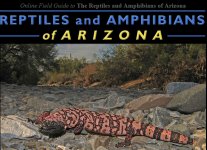| Range: |
 |
| Other Names: |
|
| Subspecies: |
Giant Spotted Whiptail Aspidoscelis burti stictogrammus |
| Description: |
The largest whiptail lizard in the United States (up to 140 mm or 5.5" from snout to vent). It is a slim, reddish brown lizard with a long, thin tail, and a slim, pointed snout. The head, neck, and tail are reddish orange. Young animals have six or seven distinct, light colored stripes on the neck and body. As males age the stripes often begin to break up into spots and additional spots begin to emerge from the dark spaces between the stripes. In some populations large adult males are spotted and lack stripes entirely. The scales on the body are small and granular. The scales on the tail are large, keeled, and rectangular. The scales on the belly are large, smooth, and rectangular. The scales on top of the head are large, smooth, and plate-like. |
| Similar Species: |
Although large adult Giant Spotted Whiptails are huge and more heavily spotted than other whiptails, younger individuals can only be distinguished with careful attention to detail. The only certain way to identify them is to count the granular scales around mid-body. The Giant Spotted Whiptail has 90 or more, while other species except the Tiger Whiptail have fewer than 89, but whiptails are hard to catch, and coloration must be used to identify species. The similar looking Sonoran Spotted Whiptail and Gila Spotted Whiptail are smaller, retain their striped patterns into adulthood, and usually do not have an orange tail. The tails of juvenile Tiger, Desert Grassland and Plains Striped Whiptails are blue and darken with age. The adult Tiger Whiptail has distintcive black pigment on the throat and shoulders. |
| Venom: |
None |
| Habitat: |
Primarily an inhabitant of the Semidesert Grassland and Madrean Evergreen Woodland communities but also follows drainages down into Chihuahuan Desertscrub in some areas. Usually encountered along canyons and drainages within mountainous terrain but in some parts of its range it encountered along riparian corridors in low valleys. |
| Behavior: |
This is an alert, fast-moving, ground-dweller that actively forages during the day. It is extremely wary and quick to flee when encountered. When pursued it is very conscious of its proximity to the pursuer and often stays just out of reach. It may flee into a burrow or under a fallen log or plant debris pile when persistently pursued. |
| Hibernation: |
It hibernates during the cold months of winter and late fall. |
| Reproduction: |
Mates in spring and lays one or two clutches of eggs in summer. Clutch size ranges from 1 to 10 eggs. |
| Diet: |
This lizard actively forages by digging under logs, wood piles, rocks, and leaf litter for a variety of insects including ants termites beetles, and caterpillars. It also eats a variety of spiders. |
Adapted from account on reptilesofaz.org
Sources:



|











